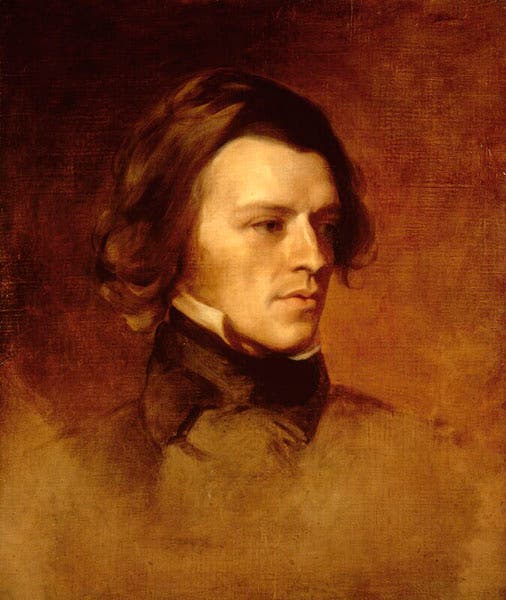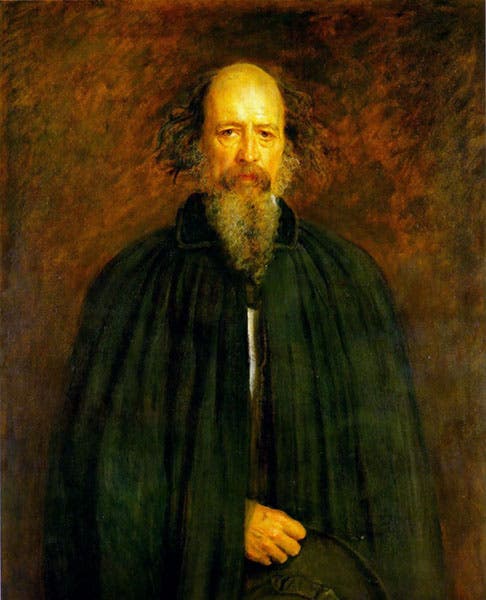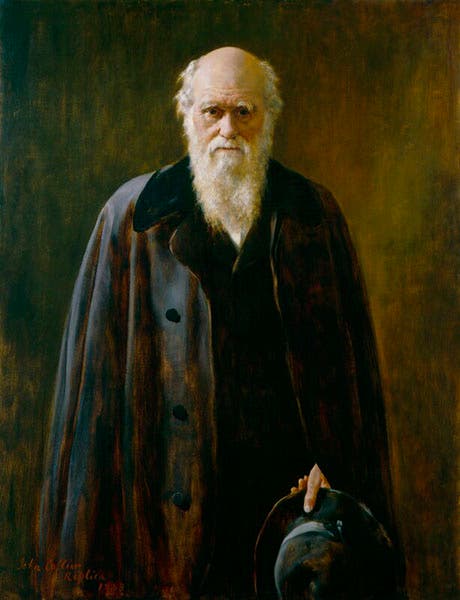Scientist of the Day - Alfred Lord Tennyson
Alfred Lord Tennyson, a Poet Laureate of England, was born Aug. 6, 1809. We do not feature many poets in these posts, even Poets Laureate, but we make an exception today, because of some uncanny parallels (and divergences) in the lives of Tennyson and Charles Darwin, and because we want to show you portraits of each that have never before, to our knowledge, been exhibited side by side.
Tennyson was born in the same year as Darwin, who was six months older. They both attended Cambridge University (although there is no indication that they met there), both went on geological excursions with Adam Sedgwick, and both read works of the philosopher William Whewell and the geologist Charles Lyell. But in October of 1833, while Darwin was in South American on HSS Beagle, Tennyson suffered an intense personal loss. Arthur Hallam, his close friend from Cambridge, who was engaged to Tennyson's sister and with whom he had travelled extensively, suddenly died in Vienna, age 22. Tennyson was bereft. Trying to express his grief, he began composing an elegy, In Memoriam, at which he labored for 16 years. The long poem (133 cantos), one of the masterpieces of 19th-century verse, was published in 1850. The portrait below shows Tennyson in 1840, when he was about half-way through his composition (second image).
One of the most unexpected features of In Memoriam are the speculations about nature, extinction, and the struggle for existence, prompted by thoughts about death. I have put together here a collage of four-line stanzas from cantos 54, 55, and 56, and reordered them, which will probably irritate any Tennyson scholars among you, but we don't have room for all three cantos, and I am not trying to analyze the poem, so I think it is excusable. I reorder because I want to show Tennyson's progression from overwhelming loss to faith via thoughts about nature:
Are God and Nature then at strife,That Nature lends such evil dreams?So careful of the type she seems,So careless of the single life;
So careful of the type?' but no.From scarped cliff and quarried stoneShe cries, `A thousand types are gone:I care for nothing, all shall go.
Who trusted God was love indeedAnd love Creation's final law—Tho' Nature, red in tooth and clawWith ravine, shriek'd against his creed—
O life as futile, then, as frail!O for thy voice to soothe and bless!What hope of answer, or redress?Behind the veil, behind the veil.
So runs my dream: but what am I?An infant crying in the night:An infant crying for the light:And with no language but a cry.
I stretch lame hands of faith, and grope,And gather dust and chaff, and callTo what I feel is Lord of all,And faintly trust the larger hope
A year after In Memoriam was published, Darwin suffered his most excruciating personal loss, with the death of his 11-year old daughter, Annie. While Tennyson was able to emerge from his ordeal with faint trust in the larger hope, Darwin was not. Whatever faith Darwin had left, died with his daughter. He would no more stretch lame hands of faith to a God he could no longer believe in.
In 1881, Tennyson sat for a portrait by John Everett Millais (fourth image). The portrait resides today in the Lady Lever Art Gallery in Liverpool, and it depicts the 72-year-old poet, still full of fire, 30 years after he gave us the memorable phrase "Nature, red in tooth and claw" that we just read. The pose is unusual, being a full-face, three-quarter view, allowing us to look Tennyson right in the eye, or vice-versa. The really eerie thing about Millais's portrait is that, at the very time it was being executed, another notable portrait painter, John Collier, was capturing his subject in an identical pose – a man gazing intently at the viewer, with a long beard, draped with a dark cape, holding a soft hat in his hand, just like Tennyson.
This sitter was Charles Darwin (fifth image). The Darwin portrait is in the Linnean Society in London, with a copy by Collier in the National Portrait Gallery, which is the one we show here. The Tennyson portrait and the Darwin portrait are almost exactly the same size, just over four feet tall and three feet wide. It would be really nice if some up-and-coming art historian would curate an exhibition that brought the two together, hanging them next to one another in some London gallery or museum. We can do so here (sixth image, below), digitally, but it is not quite the same as it would be having them together, in the flesh, as it were.

Portraits of Tennyson (left) and Darwin, side by side, 1881 and 1882 (Lady Lever Art Gallery, Liverpool, and National Portrait Gallery, London)
Dr. William B. Ashworth, Jr., Consultant for the History of Science, Linda Hall Library and Associate Professor, Department of History, University of Missouri-Kansas City. Comments or corrections are welcome; please direct to ashworthw@umkc.edu.








![Using an astrolabe to measure the depth of a well, woodcut in Elucidatio fabricae vsusq[ue] astrolabii, by Johannes Stöffler, 1513 (Linda Hall Library)](https://assets-us-01.kc-usercontent.com:443/9dd25524-761a-000d-d79f-86a5086d4774/a998eb50-55d2-4a88-ace2-a50aa5fa86e7/Stoffler%201.jpg?w=210&h=210&auto=format&fit=crop)

